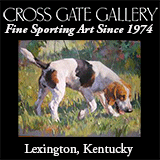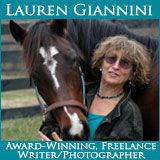Bull Run’s Spree was the top scoring foxhound in the Belle Meade Hunt Foxhound Performance Trials held in Thomson, Georgia on January 20 and 21, 2017. Of thirty-six hounds competing, Spree won three of the four scoring categories: Hunting, Trailing, and Endurance. In the Full Cry category, he was second.* His combined score led the field in points.
Six foxhounds from each of six hunts competed—Belle Meade Hunt (GA), Bridlespur Hunt (MO), Bull Run Hunt (VA), Farmington Hunt (VA), Fox River Valley Hunt (IL), and Mill Creek Hunt (IL). The three top scoring hunts, based on the combined scores of their hounds from first to third, were: Bull Run, Fox River Valley, and Belle Meade.
Trial Huntsman Sam Clifton was called upon during the award ceremonies to announce his choice—the hound he’d most like to take back to his own kennels. Huntsman’s Choice is an honorary award and receives no official prize, but, as in past trials, Sam’s reasoning for his personal choice was worth hearing.
Huntsman’s Choice
Sam explained how, at a check when hunting his own pack in Maryland, he looks for one or two of the busiest working hounds that naturally seem to break the search area into segments and proceed to hunt each segment in an organized fashion. Sam watches for a pattern to develop and tries to edge other hounds over to help. He did the same during checks and losses as trial huntsman with his new pack, and quickly zeroed in on number forty-one. He also spoke highly of numbers eighty-one and seventy-one in the same vein.
Indeed, number forty-one was Spree, who was receiving high scores from the judges all during the hunts. Number 81 was Bull Run Nicely who scored very well and came in fifth in overall points. Number seventy-one was Belle Meade Panzer.
Having completed his first performance trial as huntsman, Sam explained how impressed he’d been that eighteen couple of hounds—each a stranger to all but his five pack-mates—could meld so quickly into a working pack. It wasn’t always this way. In fact, in the first few years of experimentation at the early performance trials, it usually took a good part of the first day’s hunting just for hounds to get over their confusion and uncertainty. At some of the early trials, some huntsmen even insisted on bringing their own hounds to the field and tried to leave them with the trial huntsman. Many of those hounds simply left the pack on their huntsman’s heels as he retired to the field. The confusion could continue for hours.
It was Charles Montgomery, huntsman for the Live Oak Hounds (FL) at the time, but now hunting the Bull Run hounds, who solved the problem. Charles had served as trial huntsman during some of these early trials, and, before the first meet at one trial at Belle Meade, he collected all the hounds from all the packs into one large holding pen and stayed among them for perhaps a half-hour before the first meet, soothing and tossing biscuits. Simple. And it worked.
As a momentary sidebar, we might turn our attention to another hound competing in the trial—Bull Run Perfect. She deserves a mention on account of her history. Foxhunting Life readers may remember a series of articles published during the spring and summer of 2014 in which we followed the odyssey of two un-entered litter mates from the Live Oak Hounds (FL)—Charter and Perfect, brother and sister. The youngsters had a fright at the Virginia Foxhound Show, ran off, and wouldn’t allow themselves to be caught. Perfect was captured some days after the end of the show, returned to Live Oak, and drafted to Bull Run. And here she was, hunting with a pack of hounds as she was bred to do—a successful conclusion to the affair…for Perfect.
Her brother Charter, however, remained on the lam for nearly four months. He traveled across two main highways, about twenty miles as the crow flies, from the hound show grounds in Leesburg to Middleburg. Piedmont huntsman Spencer Allen left food for him regularly near the Middleburg Tennis Club where Charter was often seen, but was unable to approach him. Finally, a favorable ending for Charter. He was captured in a humane trap, treated, rehabbed, and given to a young vet’s assistant, and, we hope, is living happily ever after.
Belle Meade Masters Epp Wilson and Charlie Lewis organize the dinner program at Boots Hall. / Stephanie Guerlain photo
Judging and Scoring
Your Editor was honored to be appointed Trial President. There was another president in Washington, D.C. being sworn in over the same weekend, but this rabid group of sportsmen and women meeting in Georgia were rather more smitten by the voices of their hounds.
Judging the competition were: Carolyn Chapman, Farmington; Steve Clifton, huntsman, Bear Creek Hounds (GA); Ken George, huntsman, Midland Foxhounds (GA); trial huntsman Sam Clifton; Eleanor Hartwell, huntsman, Bridlespur; Ashley Hubbard, huntsman, Fox River Valley; Boo Montgomery, whipper-in, Bull Run; Brenda Yost, huntsman, Mill Creek, and yours truly.
I was fortunate to be carried by a glossy, black mount named Rubicon—a Jeep Wrangler owned and driven (aggressively) by Jim Hicks, longtime whipper-in at Belle Meade. Jim knows every inch of his country and how the coyotes run. Though this was Rubicon’s first season following hounds, he was nimble down the narrow trails and handy negotiating the sharp turns. He gleefully plunged into the water crossings and up the banks on the other side. He went everywhere the horses went, and, while he didn’t jump, he got us where we needed to go (with Jim’s foot on the accelerator) and positioned me to collect some excellent scores.
Hounds are judged over two days of hunting by judges dictating into hand-held voice recorders. Judges record the time of day, the hound numbers, and which one of four categories—Hunting, Trailing, Full Cry, and Marking—for which the hound is being scored. After each meet, judges convene to transcribe their recordings into a data entry form. A typical recording might sound like this:
“9:41. Hunting: One, Forty, Fifty-three.”
And later.
“10:53. Full Cry: Eighty-One, One, Ninety-one.”
The computer assigns numerical scores for each category, Full Cry receiving the highest number of points. The computer also gives higher scores to the hound in the lead, with decreasing scores given to the second hound in the race, third hound, and so on. The computer also increases scores as the time of day progresses in order to rank hounds for Endurance. The time of day for each score is entered to prevent multiple scoring for any hound by more than one judge; the computer takes care of that, as well!
At the end of each day, hounds are ranked by their total scores, and each hunt is ranked on the accumulated scores of all its hounds. At the conclusion of the trial the scores from both days are combined to produce the final overall rankings of individual hounds and hunts. This nifty computer program was recently posted on the MFHA website as the state of the art in Performance Trial scoring software. Its development was funded by the MFHA, and a volunteer team from Belle Meade worked with programmers located a world away, in India, to create it.
Spree
The winning foxhound is the one that proves its working ability against the five or six hounds entered by each of the competing hunts. All hounds entered are selected by their huntsmen and Masters to best represent them in competition—the cream of their respective packs. Any hound that finishes any performance trial among the top ten scorers has proven its working abilities. On another day, any top-ten finisher could well be the high scorer. For Masters or huntsmen seeking breeding stock or outcrosses for their own breeding program, the performance trial is the only venue we have that demonstrates and ranks the working abilities of individual foxhounds of all types.
Bull Run’s Spree 2015 is a Crossbred dog hound, bred and entered by the Midland Fox Hounds (GA). Spree is by Midland Rocket 2011 out of Staffordshire Moorland Stunning 2011. Stunning was Champion English Foxhound at Virginia in 2014.
Having completed his first season with the Midland pack, Spree and his littermate, Striker, went on the road to the hound shows last spring. Striker struck gold, being judged Grand Champion Foxhound at both the Virginia Foxhound Show and the Southern Hound Show earlier. Midland huntsman Ken George and some of his hounds, among them Spree and Striker, stayed over with Charles Montgomery at the Bull Run kennels between the Virginia and Bryn Mawr hound shows. Charles was looking for hounds at the time, so Ken, with Master Mason Lampton’s approval, generously gave Spree over to Charles and Bull Run.
When cubhunting started this fall, however, Spree was the odd man out. He was unknown to the pack and they ignored him. When he spoke, they didn’t honor him.
“Spree has a deep and glorious voice,” said Charles, “and typically speaks twice in succession. But he was used to hunting coyote, and the rest of the hounds weren’t because we have plenty of foxes. That may have been part of the problem.
“Then, hunting about a month ago, with three foxes in the area, Spree recovered a line in the open. He spoke twice, and I harked hounds to him. We put two foxes to ground, and from that time on Spree was a member of the pack! A star!
“The next hunting day, a Saturday, was cold and rainy. Spree found a coyote and spoke twice. Hounds harked to him on their own this time, and we ran that coyote for two hours. Spree was now a leader!
“I know that Mason is proud of Spree, proud that he gave a good hound to us, and that he’s winning!”
Each hunting morning began with a stirrup cup at Field Master Jean Derrick’s charming cottage adjacent to the Belle Meade property. / Stephanie Guerlain photo
Hunting Days
Rain had been predicted, but it held off for Day-One. Scenting was slow to improve, and the first hour was unproductive, but soon hounds had a coyote up and ran well for forty minutes, with hounds having to be stopped before a road crossing. Later, in the third hour, a second coyote—all black—was viewed by yours truly leaving a small wooded point down the trail ahead of me. Hounds had pushed him hard. The closest three were actively trailing and speaking within this little wooded point, urging the rest of the pack to come and lend a nose. One hound, number eighty-one (Bull Run Nicely) burst out of covert directly on the line of the black coyote, closely followed by the other two—numbers one and ninety-one respectively (Bull Run Dash and Fox River Valley Daffodil). The rest of the pack quickly joined the chase down the trail and away from me. Hounds ran that coyote well for a good forty-five minutes and were again stopped before a road crossing.
Weather-wise, Day-Two was another story. Rain held off at the start and hounds found quickly. This was a fast-paced hunt for all concerned—quarry, hounds, and riders. However, rain started during the hunt, accompanied by a slow roll of thunder, and steadily increased to a downpour.
That hunt was a white-knuckle ride for me, clutching the passenger’s handle and wondering whether we would slide off the causeway into the water (either side), sideswipe a tree turning a fast corner, or fish-tale into a gatepost rather than bounce through safely. My pilot Jim’s attention was riveted to the unintelligible (to me) squawks over the radio, directing judges and staff to the direction and location of hounds.
Many trail crossings and landmarks in the Belle Meade hunting country are named. This is critical when passing information by radio during a blistering coyote chase. Even many of the coops sport names as well, one often-used coop going back as far as Major Kindersley, the long-past and definitive Master of the Eglinton and Caledon Hunt (ON).
At times Jim and I were paralleling the running pack occasionally even ahead of huntsman Sam, Jim always deciding the most likely path of the coyote and how to get ahead of it. With Belle Meade Master and huntsman Epp Wilson as his guide, Sam was usually well-up with the pack, and, galloping as if she were tied to him was Field Master Jean Derrick leading the first flight of visiting huntsmen, staff, and the rest of the thrusters.
Jim changed direction after another radio message and finally stopped at a farmyard. A coyote passed me running left-handed on the other side of a wire fence perhaps twenty-five feet away. I positioned myself to record some excellent Full Cry scoring, but hounds were again stopped for their own safety before they reached me. Judges had collected good scores, the rain was pouring down, so after just one-and-a-half hours of good hunting we called it a day. It was obviously the right call, since even the Irishmen were ready to come in!
Farmington Hunt contingent enjoys cocktails in Boots Hall. From left: Ken Chapman, MFH Joy Crompton (hidden), CeCe Williamson, Robin Ellis, Kay Barquin, AnitaVere-Nicoll, Chris Middleton, KIm Gall, huntsman Matthew Cook, MFH Liz King, Shelly and Mark Thompson, Evie Cowles, Stephanie Guerlain, Carolyn Chapman, and honorary whipper-in TomBishop. / Andrea Guzinski photo
Hospitality
At day’s end, no one goes home from any Belle Meade function hungry or thirsty. Hunt breakfasts of eggs, bacon, sausage, grits, and biscuits and gravy were served after each hunt. Awards were presented after satisfying lunches or dinners. And the bar, it seems, is nearly always open. The Belle Meade Masters Epp Wilson, Charlie Lewis, and Gary Wilkes inspire all hunt members to pitch in with enthusiasm and make southern hospitality a reality felt by every visitor. The parties flow from the bar on the rear porch, through the hunt’s cozy clubhouse (Boots Hall), to the front yard where huge logs burn in a pit fire around which long benches are arranged. That’s a favorite venue for the many junior members that are encouraged by the hunt; they pitch in and have chores to perform as well. The only thing missing was a guitar and a sing-song around the fire. Epp…?
* There were no scores in the Marking category, since in all cases, the hunted coyotes crossed roads, and hounds were stopped.
Posted January 27, 2017
Click for Final Results.

















